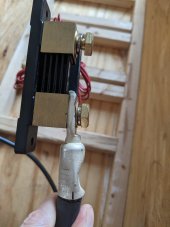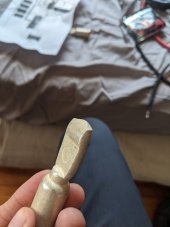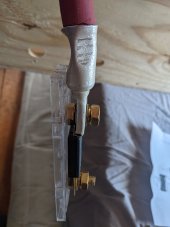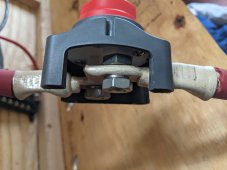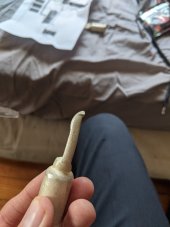I don't yet have any any other 4/0 lugs so I've been drilling through and modifying these proprietary ones made for Anderson connectors. They're not exactly straight but contact seems pretty good. Thoughts?
You are using an out of date browser. It may not display this or other websites correctly.
You should upgrade or use an alternative browser.
You should upgrade or use an alternative browser.
Is this enough lug contact?
- Thread starter starchy
- Start date
FilterGuy
Solar Engineering Consultant - EG4 and Consumers
I would say 'maybe'. My concern is that the odd shape of the lugs might be lifting them just enough to reduce contact. You definitely want check them when under load and make sure they are not heating up.I don't yet have any any other 4/0 lugs so I've been drilling through and modifying these proprietary ones made for Anderson connectors. They're not exactly straight but contact seems pretty good. Thoughts?
timselectric
If I can do it, you can do it.
- Joined
- Feb 5, 2022
- Messages
- 18,443
I would change them, at your earliest convenience.
Just keep an eye on the temperature, if you have large loads.
Just keep an eye on the temperature, if you have large loads.
crossy
Solar Addict
The trouble is, at the currents we have "pretty good" is often not good enough 
Even at our system's relatively modest currents (<100A) it doesn't take much for joints to start getting warm.
And of course, all that warmth is lost energy!
I'm with the others, get the correct lugs and swap them out ASAP.
You may also want a smear of electrical jointing compound.
Even at our system's relatively modest currents (<100A) it doesn't take much for joints to start getting warm.
And of course, all that warmth is lost energy!
I'm with the others, get the correct lugs and swap them out ASAP.
You may also want a smear of electrical jointing compound.
Last edited:
It is very easy to check voltage drop across the connection using a voltmeter, (multi-meter).
But I do wonder why you don't buy the lugs you need? I get them overnight or at worst 3 days shipping. Or I wander into a marine retailer as West Marine and pay a small premium. Much less than those lugs cost.
But I do wonder why you don't buy the lugs you need? I get them overnight or at worst 3 days shipping. Or I wander into a marine retailer as West Marine and pay a small premium. Much less than those lugs cost.
In the third picture, the shoulder of the lug is forcing the contact surface to not be level. You may have a poor connection there and it's a prime example of using the wrong tool for the job.
Like Zil said above, West Marine does carry lugs. My local Ace Hardware also had a good selection of copper lugs, but they were not coated, just bare copper. Most of my lugs came from TemcoIndustrial.com.
Like Zil said above, West Marine does carry lugs. My local Ace Hardware also had a good selection of copper lugs, but they were not coated, just bare copper. Most of my lugs came from TemcoIndustrial.com.
schmism
Solar Addict
I dont see anything wrong with them (the note shoulder above should be noted). On the post connections a standard lug isnt going to offer you an more surface area contact than what you currently have.
ChrisFullPower
Inverter Snob
UL listed 4/0 lugs are $5. And a hammer crimper is $20. No reason not to do it properly.
littleharbor2
Solar Addict
4/0 lugs really need to be hydraulically crimped to cold fuse strands and lug body togetherUL listed 4/0 lugs are $5. And a hammer crimper is $20. No reason not to do it properly.
chrisski
Solar Boondocker
- Joined
- Aug 14, 2020
- Messages
- 5,173
UL listed 4/0 lugs are $5. And a hammer crimper is $20. No reason not to do it properly.
I agree with UL lugs being $5 and to hydraulically crimp, not hammer crimp. Appears in the OP’s pics, the crimp is hammered.4/0 lugs really need to be hydraulically crimped to cold fuse strands and lug body together
I just want to add that if the load is small, the voltage drop may not show.It is very easy to check voltage drop across the connection using a voltmeter, (multi-meter).
I would get rid of those lugs, buy the UL ones, and spend $100 on a hydraulic crimper.
alright, i ordered more lugs (these):
and a hydraulic crimper:
i suppose i'm meant to remove the existing lugs and crimp new ones rather than just recrimp the hammer crimped ones, eh?
and a hydraulic crimper:
i suppose i'm meant to remove the existing lugs and crimp new ones rather than just recrimp the hammer crimped ones, eh?
timselectric
If I can do it, you can do it.
- Joined
- Feb 5, 2022
- Messages
- 18,443
Yes
chrisski
Solar Boondocker
- Joined
- Aug 14, 2020
- Messages
- 5,173
This will work, but I notice that hydraulic crimper is in metric. If you buy SAE wire sizes like 4/0, you may have to go one size underneath on the dies. That will make “Wings” on each side. I see nothing wrong with having wings.and a hydraulic crimper:
https://www.amazon.com/dp/B00ZA2P3XM?psc=1&ref=ppx_yo2_dt_b_product_details
I have a SAE TEMCO 10 AWG to 500 MCM crimper. The correct sized lug is too big, and I have to go one down, and I get wings anyways. A 4/0 wire I crimp in a 4/0 lug can be pulled out by hand, so I go down to a 2/0 die with 4/0 wire And this makes wings.
Bare copper may work, but I recommend the ones I used that are tinned:alright, i ordered more lugs (these):
https://www.amazon.com/dp/B085BP2J82?psc=1&ref=ppx_yo2_dt_b_product_details
WYtreasure
It's not happy hour, I'm just like this.
I use the same brand of lugs. Hydraulic crimpers are cool. Hopefully you can find the correct size die in your kit.
My signature has a link to battery melt down, in case you have any questions about heat.
My signature has a link to battery melt down, in case you have any questions about heat.
littleharbor2
Solar Addict
The 150 dies are the right size for 4/0 lugs
Similar threads
- Replies
- 25
- Views
- 2K
- Replies
- 13
- Views
- 1K
- Replies
- 11
- Views
- 512
- Replies
- 8
- Views
- 241
- Replies
- 9
- Views
- 648



